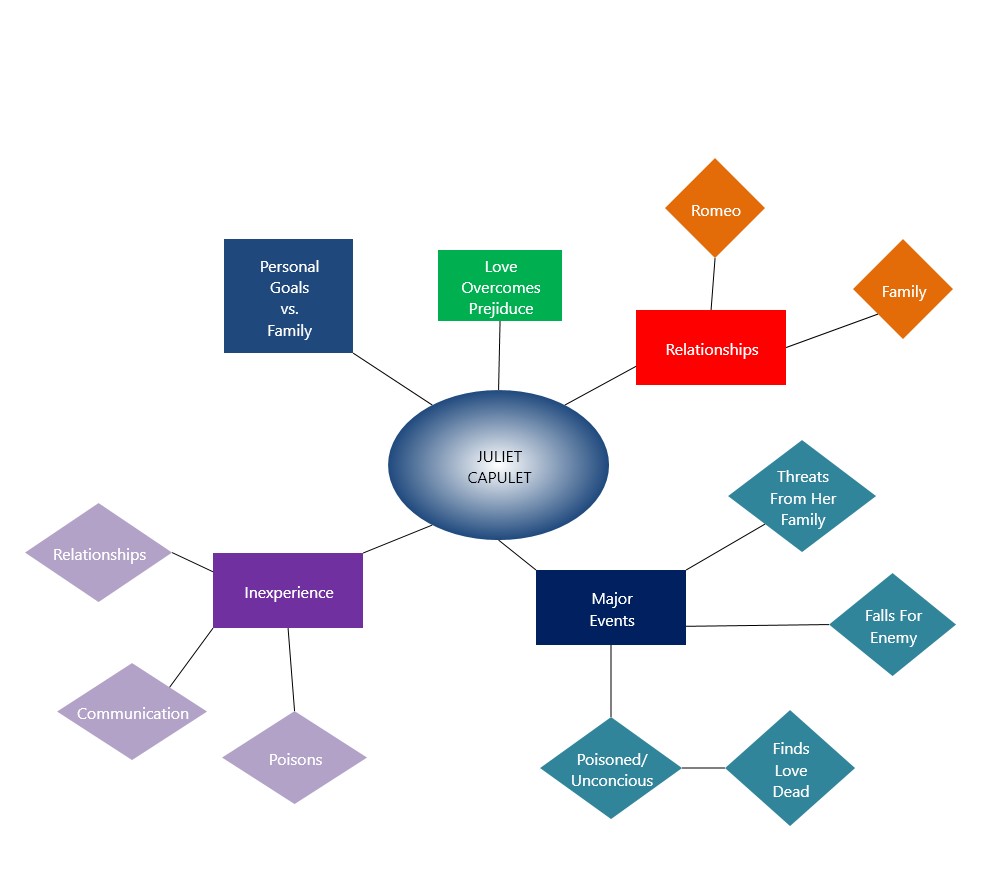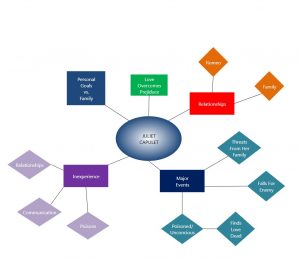
Mind Mapping and Spiderwebbing Your Ideas
Sometimes I have an idea for a piece of writing (the topic for a blog post, for instance, or the main character relationships for a short story) but then I get stuck on developing the meat of the idea. It’s like – I know the idea is there in my brain. I had an idea of what I wanted to do when I pitched it, but when faced with the blank page and getting the idea out of my head into a form that makes sense, I just hit a wall.
It can be easy to just chalk this up to writer’s block, walk away from the keyboard and decide that someday you will write the story or the article . . . when you’re inspired. But let me tell you a secret: the odds that inspiration will fall on me like a blinding bolt of lightning are pretty slim. And you’re cheating yourself to decide that you just have to wait for chance or the universe or whatever, like you have no power over your own work or your own process.
This is where techniques like brainstorming work for me. I am a big fan of list making. I’ll write out something like, “The secret in Arlo’s backstory is . . .,” at the top of the page, and then force myself to think if ten possible secrets that character might have. Or I’ll write something like, “Ten takeaways for readers about list making,” and then list out ten techniques for really making listing work. (The finished article may focus on five, or take a different structure altogether, depending on how many items on the list are workable.)
But what can you do if that doesn’t work? Writing is always about controlling information. In fiction, it’s deciding where to put the big revelations so that readers are prepared for them psychologically – but still gasp. In nonfiction, it is about making sure concepts are understood clearly when introduced, so that when you build on them, readers can follow you to your well-crafted conclusion. I personally don’t always think of information in the order in which it eventually gets presented, and I think that’s why listing doesn’t always give me the ability to get what’s in my brain moving towards being on the page. Sometimes I need to think about the information in a non-linear fashion, and that’s where mind mapping and spiderwebbing come in.
 Making a spider diagram is the simpler of the two methods. Write the main topic of what you want to write about in the center of your paper and draw an oval around it. Write ideas that connect to this main idea around it, placing each inside an oval, and draw lines connecting the ovals to show how the ideas connect to each other. This allows you to follow where your brain wants to go when exploring the idea quickly, before you forget any pieces of it. This stream-of-consciousness technique allows for nonlinear thinking. It is often what gets me unstuck. Say that the listing exercise above helped me figure out what Arlo’s backstory secret really was, but I’m not sure how knowing that piece of information is going to affect the story I’m writing. I can create a spiderweb around the central idea of, “How does knowing this secret change the relationship between Felicity and Arlo?” Somewhere in the ring of ideas, or in the sub-ideas coming off of that initial ring, I’m going to find something one or both characters are going to do, which can then have consequences that will launch me into the story.
Making a spider diagram is the simpler of the two methods. Write the main topic of what you want to write about in the center of your paper and draw an oval around it. Write ideas that connect to this main idea around it, placing each inside an oval, and draw lines connecting the ovals to show how the ideas connect to each other. This allows you to follow where your brain wants to go when exploring the idea quickly, before you forget any pieces of it. This stream-of-consciousness technique allows for nonlinear thinking. It is often what gets me unstuck. Say that the listing exercise above helped me figure out what Arlo’s backstory secret really was, but I’m not sure how knowing that piece of information is going to affect the story I’m writing. I can create a spiderweb around the central idea of, “How does knowing this secret change the relationship between Felicity and Arlo?” Somewhere in the ring of ideas, or in the sub-ideas coming off of that initial ring, I’m going to find something one or both characters are going to do, which can then have consequences that will launch me into the story.
If you are not a fan of doing things on paper, you can use flowchart software to make this kind of diagram. There are a number of free options, but I use Diagram Ring.
 A mind map is in some ways similar to a spider diagram. You do still have the radial non-linear design, but there is more hierarchical structure in a mind map – and it contains visual elements. There are “rules” to mind mapping that are designed to take the logical left hemisphere of the brain that likes key words and emphasizing points and force it to play nice with the right hemisphere, as you create a map that is itself a piece of art. This can unlock creativity in ways that can blast you past stuck points and re-invigorate enthusiasm for your project. I find this technique works better for me when I need to build something more complicated than a spiderweb can handle.
A mind map is in some ways similar to a spider diagram. You do still have the radial non-linear design, but there is more hierarchical structure in a mind map – and it contains visual elements. There are “rules” to mind mapping that are designed to take the logical left hemisphere of the brain that likes key words and emphasizing points and force it to play nice with the right hemisphere, as you create a map that is itself a piece of art. This can unlock creativity in ways that can blast you past stuck points and re-invigorate enthusiasm for your project. I find this technique works better for me when I need to build something more complicated than a spiderweb can handle.
When you create a mind map, instead of writing out full sentences or phrases, concentrate on key words. (Imagine you are doing search engine optimization for your project, or hashtagging a social media post.) Use larger letters and bolder colors for words/images that should have more emphasis. Decide if specific colors correlate to different aspects of your idea, which can help you separate the threads of thought mentally. Find photos or sketch images that represent the different aspects of the idea. Is there something in any of these images that springboard out to new ideas? Ideas should all radiate out from the central word/image, but don’t try connecting the spokes, or allowing ideas to circle back on themselves.
Here is a mind map I mocked up for a hypothetical article on what to consider if you are going to get a cat.
—–Insert mind map image here!!!
Whatever method you use, just getting SOMETHING about the project down on paper will help get the ideas and creativity flowing.

